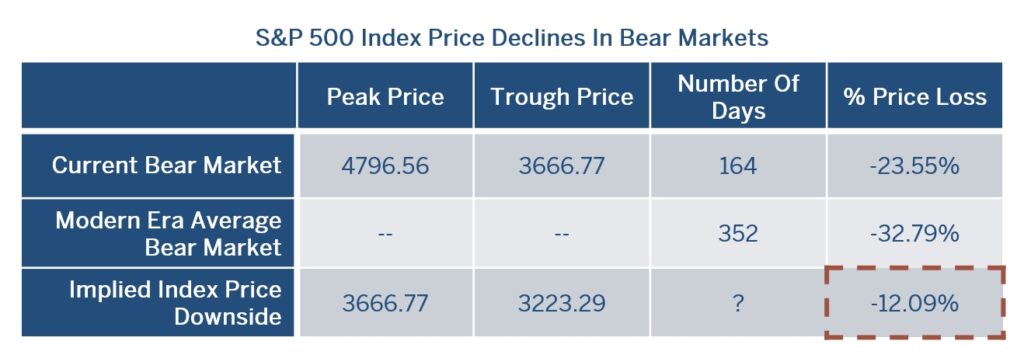Market Outlook
Against a backdrop of sky-high inflation, rising rates, and growing recession concerns, the S&P 500 Index has clocked its worst start to the year in over 50 years. The strongest bull market on record has officially turned into a bear given the index’s decline of over 20% from its January 3rd record high. Unfortunately, safety has not been found in fixed income, as long-dated U.S. government bond prices are off more than 25% this year. The shift has been fast and frustrating, as many of the forces behind the decline have been beyond the control of investors and policymakers alike. This quarter, we find it important to discuss what we think the dreaded “R” word would entail, what a bottom in stocks could look like, and how to position within various forward-looking scenarios.
1. The “R” Word
Any reference to the dreaded economic phase of “recession” has an uncanny ability to stoke fear among the general public. A recession is just one phase of a normal business cycle. Today, that phase would likely look quite different than those experienced in recent history.
To be clear, we are not currently in a recession by official measures. By definition, a recession is a temporary economic decline, generally measured by a fall in Gross Domestic Product (GDP) in two successive quarters. A phase of the business cycle is not dependent on, nor necessarily indicative of, the performance of investable assets in financial markets. However, as is human nature, most individuals assume parallels between a current or future situation and those personally experienced in the past. In this case, muttering the dreaded “R” word invokes fears of economic and financial market turmoil equivalent to the near 15% unemployment rate during the pandemic-induced recession in 2020, the near-collapse of the global financial system through The Great Recession, or the -49% drawdown in U.S. stocks seen during the early 2000s recession. Regarding economics and corporate fundamentals, the current backdrop in the U.S. is vastly different than the three most recent recessions, and our view is that any upcoming recession would be of a much milder variety.
Download the full PDF report to get more details and take a closer look at the graphs presented in the video.
2. Finding A Bottom
While market timing is a fruitless endeavor for long-term investors, it is valuable to utilize historical context to understand how long selling pressure may persist, at what levels meaningful shifts in the equity market could occur, and why adding at these levels may be the best strategy.
Calling for a bottom in the stock market is very difficult, as every cycle is different. However, employing historical context can help identify potential price levels at which selling pressure may subside. Looking at historical returns in the U.S. through the modern era (post World War II), the average bear market lasted 352 days and exhibited a price loss of -32.79%. Based on the historical average loss and current severity of the drawdown, the implied potential downside to the S&P 500 Index’s price as of this writing is -12.09%. See the chart below for details.

3. Blue Chip Radar
What direction do we see financial markets heading in over the next 12 months? The last three months exhibited aspects of both the bear and base cases that we outlined in the Q2 2022 Quarterly Edge, but this should be viewed as a 12-month outlook. Many of the underlying drivers of our updated Blue Chip Radar have stayed consistent, but given market dislocations, our preferred positioning in the various scenarios has changed.
Download the full Q3 2022 Report below to get more insight from Blue Chip Partners.
Blue Chip Partners Quarterly Edge Report – July 2022
Expressions of opinion are as of 30 June 2022 and are subject to change without notice. Any information provided is not a complete summary or statement of all available data necessary for making an investment decision and does not constitute a recommendation to buy, hold, or sell any security. There are limitations associated with the use of any method of securities analysis. The information has been obtained from sources considered to be reliable, but we do not guarantee that the foregoing material is accurate or complete. Every investor’s situation is unique, and you should consider your investment goals, risk tolerance, and time horizon before making any investment. Prior to making an investment decision, please consult with your financial advisor about your individual situation. Past performance does not guarantee future results. Investing involves risk, and you may incur a profit or loss regardless of strategy selected. There is no guarantee that any statements, opinions, or forecasts provided herein will prove to be correct. Dividends are not guaranteed and must be approved by the company Board of Directors. Indices are included for informational purposes only; investors cannot invest directly in any index.
1Sources: U.S. Household Net Worth: Board of Governors of the Federal Reserve System (US). As of 31 March 2022. Consumer Spending (Goods) and Consumer Spending (Services): U.S. Bureau of Economic Analysis. As of 30 April 2022.
2Sources: Board of Governors of the Federal Reserve System (US), company data. As of 24 June 2022. U.S. bank holding companies (BHCs), savings and loan holding companies (SLHCs), and intermediate holding companies of foreign banking organizations (IHCs) with $100 billion or more in assets are subject to the Board’s supervisory stress test rule. Further information on stress testing results and methodology can be found at the following link: https://www.federalreserve.gov/publications/dodd-frank-act-stress-test-publications.htm.
3Sources: Blue Chip Partners with data from Bloomberg. As of 16 June 2022. Indexes are shown for illustrative purposes only. It is not possible to invest directly in an index.